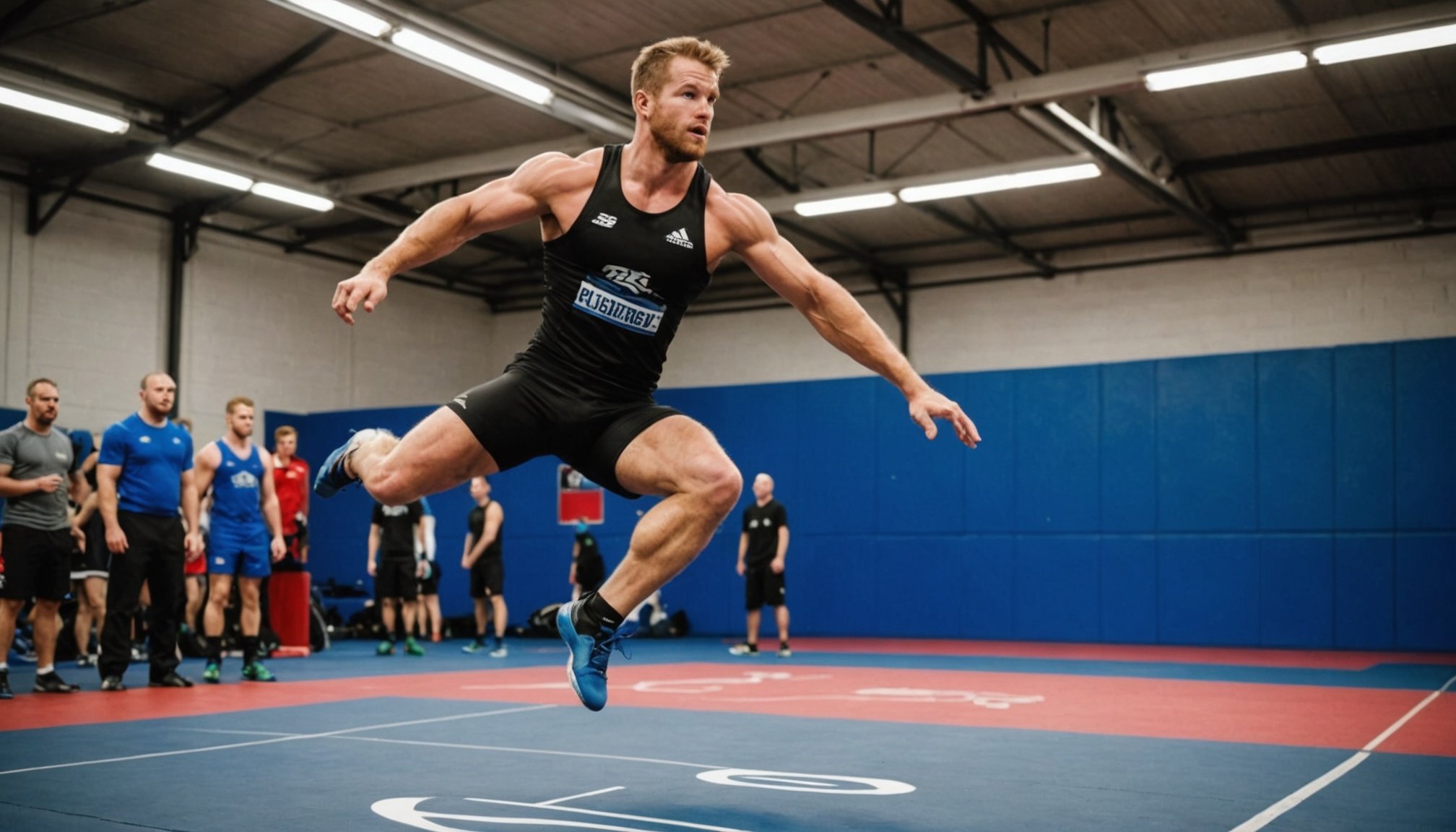Unlocking Explosive Power: A Guide to Plyometric Training for UK Wrestlers
Understanding Plyometric Training
Plyometric training, often referred to as jump training, is a specialized form of strength training designed to enhance muscular power and explosiveness. For UK wrestlers, this type of training can be a game-changer, as it directly translates to improved performance on the mat. Here’s why plyometrics are essential and how they can be integrated into a wrestler’s training program.
The Science Behind Plyometrics
Plyometric exercises involve rapid, high-intensity movements that aim to maximize the force generated by the muscles in the shortest amount of time possible. This is achieved through the stretch-shortening cycle, where the muscle is first lengthened (eccentric phase) and then immediately shortened (concentric phase). This cycle is crucial for generating explosive power.
Additional reading : Integrating Mindfulness in UK Martial Arts: Enhancing Curriculum with Mindful Practices
For example, when a wrestler performs a box jump, they first descend into a squat position (eccentric phase), and then immediately jump up onto the box (concentric phase). This rapid transition from lengthening to shortening maximizes the force output, enhancing the wrestler’s explosive power.
Benefits for Wrestlers
Enhanced Athletic Performance
Plyometric training can significantly improve a wrestler’s athletic performance by increasing their power, speed, and agility. Here are some key benefits:
- Power and Speed: Plyometric exercises such as jump squats, box jumps, and burpees enhance the ability to generate force quickly, which is critical in wrestling for takedowns, escapes, and defending against opponents.
- Agility and Quickness: Plyometrics improve the wrestler’s ability to change direction rapidly, a key aspect of wrestling that involves quick movements and reactions.
- Injury Prevention: Strengthening the muscles and connective tissues through plyometric training can help reduce the risk of injury by improving joint stability and resilience.
Real-World Examples
Many successful wrestlers and combat sports athletes incorporate plyometric training into their routines. For instance, Olympic wrestler Jordan Burroughs is known for his explosive takedowns, which he attributes partly to his rigorous plyometric training.
“I believe that plyometrics are essential for any wrestler looking to improve their explosiveness. It’s not just about strength; it’s about being able to apply that strength quickly and efficiently,” Burroughs said in an interview.
Designing a Plyometric Training Program
Lower Body Focus
For wrestlers, the lower body is crucial for generating power and stability. Here are some key plyometric exercises to include in your training program:
- Box Jumps: Jumping onto a box or bench to develop explosive power in the legs.
- Sets and Reps: 3-5 sets of 5-10 reps.
- Tips: Start with a lower box height and gradually increase as you build power.
- Depth Jumps: Jumping down from a height and immediately jumping up as high as possible.
- Sets and Reps: 3-5 sets of 5-10 reps.
- Tips: Focus on quick turnaround time between the descent and ascent.
- Single Leg Hops: Hopping on one leg to improve balance and unilateral strength.
- Sets and Reps: 3-5 sets of 10-15 reps per leg.
- Tips: Start with shorter distances and increase as you build strength and stability.
Upper Body and Core
While the lower body is the primary focus, incorporating upper body and core plyometrics can enhance overall athletic performance:
- Medicine Ball Throws: Throwing a medicine ball against a wall or to a partner to develop explosive upper body power.
- Sets and Reps: 3-5 sets of 10-15 reps.
- Tips: Use different types of throws (e.g., rotational, overhead) to target various muscle groups.
- Boxer’s Punches: Performing rapid punching movements to improve hand speed and power.
- Sets and Reps: 3-5 sets of 30-60 seconds.
- Tips: Use light weights or no weights at all to focus on speed.
Sample Training Session
Here’s an example of what a plyometric training session might look like for a UK wrestler:
Warm-Up (15-20 minutes)
- Light cardio (jogging, jumping jacks)
- Dynamic stretching (leg swings, arm circles)
- Muscle activation exercises (glute bridges, planks)
Lower Body Plyometrics (30-40 minutes)
- Box Jumps: 3 sets of 8 reps
- Depth Jumps: 3 sets of 8 reps
- Single Leg Hops: 3 sets of 12 reps per leg
Upper Body and Core Plyometrics (20-30 minutes)
- Medicine Ball Throws: 3 sets of 12 reps
- Boxer’s Punches: 3 sets of 45 seconds
Cool-Down (10-15 minutes)
- Static stretching (hamstrings, quadriceps, chest)
- Foam rolling or self-myofascial release
Managing Risk of Injury
While plyometric training is highly beneficial, it also carries a risk of injury if not performed correctly. Here are some tips to minimize this risk:
Progressive Overload
Gradually increase the intensity of your workouts by adding height, weight, or reps over time. This allows your body to adapt without sudden spikes in stress.
Proper Technique
Ensure you are performing each exercise with correct form. For example, in box jumps, land softly on the balls of your feet to reduce impact on your joints.
Warm-Up and Cool-Down
Always warm up thoroughly before starting plyometric exercises and cool down afterwards to prevent muscle soreness and injury.
Long-Term Benefits and Maintenance
Long-Term Athletic Performance
Consistent plyometric training can lead to long-term improvements in athletic performance. Here’s how to maintain these benefits:
- Periodization: Vary your training program over different periods to avoid plateaus and prevent overtraining.
- Incorporating Strength Training: Combine plyometrics with strength training to ensure overall muscle development and power enhancement.
- Active Recovery: Include active recovery days with lighter activities like yoga or light cardio to allow your muscles to recover.
Example from Combat Sports
Athletes in other combat sports like muay thai and jiu jitsu also benefit from plyometric training. For instance, muay thai fighters use plyometrics to enhance their kicking power and agility.
“Plyometric training has been a game-changer for my muay thai career,” said muay thai champion, Joanna Jedrzejczyk. “It’s helped me increase my kicking power and speed, which has given me a significant edge in the ring.”
Practical Fitness Tips for Wrestlers
Range of Motion
Ensure you maintain a full range of motion during plyometric exercises. For example, in a squat jump, make sure to lower yourself into a full squat before exploding upwards.
Muscle Conditioning
Incorporate strength conditioning exercises to complement your plyometric training. This could include weight training for the lower body, such as squats and deadlifts.
Nutrition and Recovery
Pay attention to your nutrition and recovery strategies. Adequate protein intake is crucial for muscle repair and growth, while proper rest and recovery ensure you can perform at your best during training sessions.
Plyometric training is a powerful tool for UK wrestlers looking to enhance their explosive power, speed, and overall athletic performance. By understanding the science behind plyometrics, designing a well-structured training program, and managing the risk of injury, wrestlers can unlock their full potential and gain a competitive edge on the mat.
Remember, consistency and patience are key. Long-term commitment to plyometric training, combined with strength conditioning and proper recovery, will yield significant improvements in your wrestling performance.
Detailed Bullet Point List: Key Plyometric Exercises for Wrestlers
-
Box Jumps
-
Stand in front of a box or bench
-
Descend into a squat position
-
Immediately jump up onto the box
-
Step down carefully and repeat
-
Sets and Reps: 3-5 sets of 5-10 reps
-
Tips: Start with lower box height and increase as you build power
-
Depth Jumps
-
Stand on a box or bench
-
Jump down to the ground
-
Immediately jump up as high as possible
-
Focus on quick turnaround time
-
Sets and Reps: 3-5 sets of 5-10 reps
-
Tips: Start with lower heights and increase as you build power
-
Single Leg Hops
-
Stand on one leg
-
Hop forward a short distance
-
Land softly on the same leg
-
Repeat on the other leg
-
Sets and Reps: 3-5 sets of 10-15 reps per leg
-
Tips: Start with shorter distances and increase as you build strength and stability
-
Medicine Ball Throws
-
Hold a medicine ball
-
Perform rotational or overhead throws against a wall or to a partner
-
Focus on explosive power
-
Sets and Reps: 3-5 sets of 10-15 reps
-
Tips: Use different types of throws to target various muscle groups
-
Boxer’s Punches
-
Perform rapid punching movements
-
Use light weights or no weights at all to focus on speed
-
Sets and Reps: 3-5 sets of 30-60 seconds
-
Tips: Incorporate different punching techniques (e.g., jabs, hooks)
Comprehensive Table: Comparison of Plyometric Exercises
| Exercise | Muscle Groups Involved | Sets and Reps | Tips |
|---|---|---|---|
| Box Jumps | Quadriceps, Hamstrings | 3-5 sets of 5-10 | Start with lower box height and increase as you build power. |
| Depth Jumps | Quadriceps, Hamstrings | 3-5 sets of 5-10 | Start with lower heights and increase as you build power. |
| Single Leg Hops | Quadriceps, Hamstrings | 3-5 sets of 10-15 | Start with shorter distances and increase as you build strength. |
| Medicine Ball Throws | Upper Body, Core | 3-5 sets of 10-15 | Use different types of throws to target various muscle groups. |
| Boxer’s Punches | Upper Body | 3-5 sets of 30-60 seconds | Use light weights or no weights at all to focus on speed. |
By following this guide, UK wrestlers can effectively integrate plyometric training into their fitness regimen, leading to enhanced explosive power, improved athletic performance, and a competitive edge in their sport.











